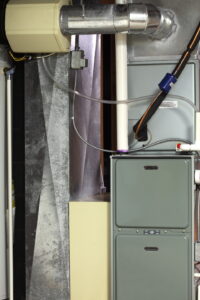
Your furnace provides warm comfort throughout the fall and winter seasons. It keeps your home cozy, but it also has a few hazards that you need to be aware of. If you stay on top of your maintenance, repairs, and know how to look for carbon monoxide leaks, you’ll be able to keep your home safe.
We want to emphasize that if you suspect a carbon monoxide leak at all, you should not address it on your own. That’s what our furnace service in Bossier City LA is for. Our expert technicians will be able to enter your home safely, turn off your furnace, and repair the source of the leak to keep your family safe. In many cases, these leaks originate from a cracked heat exchanger, which is not a DIY repair.
If you don’t know how to identify a leak, here’s what you need to know.
Identifying Dangerous Flame Colors
If you own a gas stove, you know that when you turn the knob and hear the fire click to life, it’s supposed to burn blue. If the flames come out orange or yellow, that means there’s carbon monoxide present in the air.
Recognizing Carbon Monoxide Symptoms
Carbon monoxide exposure brings on some seriously disorienting symptoms. If you’re experiencing sudden onset headaches, random out-of-nowhere dizziness, or you’re just feeling nauseous for no discernible reason, it could be due to a carbon monoxide leak in your home.
Spotting Carbon Buildup
Your furnace should not have stains on it. If it has black soot-like stains, that’s a classic sign of a carbon monoxide leak. Keep in mind, the burners of your furnace will produce some soot-like residue as well. It’s when there’s soot-like stains all over your furnace or located in multiple areas that are not adjacent to the burners that you need to be concerned.
Identifying a Cracked Heat Exchanger
This is likely where the leak is coming from in the first place. Your heat exchanger takes heat from one place and brings it to another. When you burn gas or propane, combustion byproducts escape through the heat exchanger to be vented outdoors. A cracked exchanger disrupts this process, allowing harmful gases into your home. If you’re unsure whether to continue repairing such issues, it may be time to replace your furnace using the 50% or $5,000 rule to make the safest and most cost-effective decision.
Your heat exchanger is supposed to work as a container for those gasses as they travel through the flue and outside of your home. Consider it the gate for safe ventilation. If your heat exchanger cracks, a slow leak of carbon monoxide begins to poison the air in your home.
Cracked heat exchangers aren’t always visible. It’s not like seeing a large split in the side of a cast iron wood stove; they can be extremely small. If small cracks inside of the exchanger are present, carbon monoxide will leak through them. If you can already see a large split on the exterior of your heat exchanger, it’s enough of a reason to evacuate your home and call for emergency repair.
Immediate Furnace Repair Required
Carbon monoxide is a silent killer. It’s odorless and invisible, so you often don’t know there’s a problem until it becomes serious or life-threatening. If you suspect that your furnace is leaking carbon monoxide for any reason, whether it’s a detector going off or not, it’s important to call for a repair technician as soon as possible. It’s also a good time to consider whether to repair or replace your old furnace if repeated problems are making your system unsafe.
Contact us today to schedule an appointment for maintenance or repairs to your furnace and keep your family safe.









